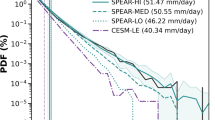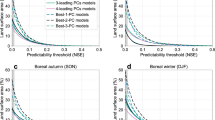Abstract
Warming of the climate is now unequivocal. The water holding capacity of the atmosphere increases by about 7% per °C of warming, which in turn raises the expectation of more intense extreme rainfall events. Meeting the demand for robust projections for extreme short-duration rainfall is challenging, however, because of our poor understanding of its past and future behaviour. The characterization of past changes is severely limited by the availability of observational data. Climate models, including typical regional climate models, do not directly simulate all extreme rainfall producing processes, such as convection. Recently developed convection-permitting models better simulate extreme precipitation, but simulations are not yet widely available due to their computational cost, and they have their own uncertainties. Attention has thus been focused on precipitation–temperature relationships in the hope of obtaining more robust extreme precipitation projections that exploit higher confidence temperature projections. However, the observed precipitation–temperature scaling relationships have been established almost exclusively by linking precipitation extremes with day-to-day temperature variations. These scaling relationships do not appear to provide a reliable basis for projecting future precipitation extremes. Until better methods are available, the relationship of the atmosphere's water holding capacity with temperature provides better guidance for planners in the mid-latitudes, albeit with large uncertainties.
This is a preview of subscription content, access via your institution
Access options
Access Nature and 54 other Nature Portfolio journals
Get Nature+, our best-value online-access subscription
$29.99 / 30 days
cancel any time
Subscribe to this journal
Receive 12 print issues and online access
$259.00 per year
only $21.58 per issue
Buy this article
- Purchase on Springer Link
- Instant access to full article PDF
Prices may be subject to local taxes which are calculated during checkout




Similar content being viewed by others
References
Summary for Policymakers in Climate Change 2013: The Physical Science Basis (eds Stocker, T. F. et al.) 1–27 (IPCC, Cambridge Univ. Press, 2013).
Boer, G. J. Climate change and the regulation of the surface moisture and energy budgets. Clim. Dynam. 8, 225–239 (1993).
Allen, M. R. & Ingram, W. J. Constraints on future changes in climate and the hydrological cycle. Nature 419, 224–232 (2002).
Trenberth, K. E. Conceptual framework for changes of extremes of the hydrological cycle with climate change. Climatic Change 42, 327–339 (1999).
Westra, S., Alexander, L. V. & Zwiers, F. W. Global increasing trends in annual maximum daily precipitation. J. Clim. 26, 3904–3918 (2013).
Westra, S. et al. Future changes to the intensity and frequency of short-duration extreme rainfall. Rev. Geophys. 52, 522–555 (2014).
O'Gorman, P. A. Precipitation extreme under climate change. Curr. Clim. Change Rep. 1, 49–59 (2015).
Kharin, V. V., Zwiers, F. W., Zhang, X. & Wehner, M. Changes in temperature and precipitation extremes in the CMIP5 ensemble. Climatic Change 119, 345–357 (2013).
Zhang, X., Wan, H., Zwiers, F. W., Hegerl, G. C. & Min, S.-K. Attributing intensification of precipitation extremes to human influence. Geophy. Res. Lett. 40, 5252–5257 (2013).
O'Gorman, P. & Schneider, T. The physical basis for increases in precipitation extremes in simulations of 21st-century climate change. Proc. Natl Acad. Sci. USA 106, 14773–14777 (2009).
Shi, X. & Durran, D. R. The response of orographic precipitation over idealized mid-latitude mountains due to global increases in CO2 . J. Clim. 27, 3938–3956 (2014).
Shi, X. & Durran, D. R. Sensitivities of extreme precipitation to global warming are lower over mountain than over oceans and plains. J. Clim. 29, 4779–4791 (2016).
O'Gorman, P. A. Sensitivity of tropical precipitation extremes to climate change. Nat. Geosci. 5, 697–700 (2012).
Kumar, S. et al. Terrestrial contribution to the heterogeneity in hydrological changes under global warming. Wat. Resour. Res. 52, 3127–3142 (2016).
O'Gorman, P. A. & Muller, C. J. How closely do changes in surface and column water vapor follow Clausius–Clapeyron scaling in climate change simulations? Environ. Res. Lett. 5, 025207 (2010).
Eden, J. M., Wolter, K., Otto, F. E. L. & van Oldenborgh, G. J. Multi-method attribution analysis of extreme precipitation in Boulder, Colorado. Environ. Res. Lett. 11, 124009 (2016).
Min, S. K., Zhang, X., Zwiers, F. W. & Hegerl, G. C. Human contribution to more-intense precipitation extremes. Nature 470, 378–381 (2011).
Lenderink, G. & Attema, J. A simple scaling approach to produce climate scenarios of local precipitation extremes for the Netherlands. Environ. Res. Lett. 10, 085001 (2015).
Wasko, C., Sharma, A. & Johnson, F. Does storm duration modulate the extreme precipitation–temperature scaling relationship? Geophys. Res. Lett. 42, 8783–8790 (2015).
Lenderink, G. & van Meijgaard, E. Increase in hourly precipitation extremes beyond expectations from temperature changes. Nat. Geosci. 1, 511–514 (2008).
Lenderink, G. & van Meijgaard, E. Linking increases in hourly precipitation extremes to atmospheric temperature and moisture changes. Environ. Res. Lett. 5, 025208 (2010).
Hardwick-Jones, R., Westra, S. & Sharma, A. Observed relationships between extreme sub-daily precipitation, surface temperature, and relative humidity. Geophys. Res. Lett. 37, L22805 (2010).
Lenderink, G., Mok, H. Y., Lee, T. C. & Van Oldenborgh G. J. Scaling and trends of hourly precipitation extremes in two different climate zones — Hong Kong and the Netherlands. Hydrol. Earth Syst. Sci. 8, 4701–4719 (2011).
Shaw, S. B., Royem, A. A. & Riha, S. J. The relationship between extreme hourly precipitation and surface temperatures in different hydroclimatic regions of the United States. J. Hydrometeorol. 12, 319–325 (2011).
Utsumi, N., Seto, S., Kanae, S., Maeda, E. E. & Oki, T. Does higher surface temperature intensify extreme precipitation? Geophys. Res. Lett. 38, L16708 (2011).
Yu, R. & Li, J. Hourly rainfall changes in response to surface air temperature over eastern contiguous China. J. Clim. 25, 6851–6861 (2012).
Mishra, V., Wallace, J. M. & Lettenmaier, D. P. Relationship between hourly extreme precipitation and local air temperature in the United States. Geophys. Res. Lett. 39, L16403 (2012).
Berg, P. & Haerter, J. O. Unexpected increase in precipitation intensity with temperature — a result of mixing precipitation types? Atmos. Res. 119, 56–61 (2013).
Berg, P., Moseley, C. & Haerter, J. O. Strong increase in convective precipitation in response to higher temperatures. Nat. Geosci. 6, 181–185 (2013).
Drobinski, P., Alonzo, B., Bastin, S., Da Silva, N. & Muller, C. J. Scaling of precipitation extremes with temperature in the French Mediterranean region: what explains the hook shape? J. Geophys. Res. Atmos. 121, 3100–3119 (2016a).
Drobinski, P. et al. Scaling precipitation extremes with temperature in the Mediterranean: past climate assessment and projection in anthropogenic scenarios. Clim. Dynam. http://dx.doi.org/10.1007/s00382-016-3083-x (2016).
Wasko, C. & Sharma, A. Quantile regression for investigating scaling of extreme precipitation with temperature. Wat. Resour. Res. 50, 3608–3614 (2014).
Ban, N., Schmidli, J. & Schaer, C. Heavy precipitation in a changing climate: does short-term summer precipitation increase faster? Geophys. Res. Lett. 42, 1165–1172 (2015).
Chan, S. C. et al. Downturn in scaling of UK extreme rainfall with temperature for future hottest days. Nat. Geosci. 9, 24–28 (2016).
Molnar, P., Fatichi, S., Gaál, L., Szolgay, J. & Burlando, P. Storm type effects on super Clausius–Clapeyron scaling of intense rainstorm properties with air temperature. Hydrol. Earth Syst. Sci. 19, 1753–1766 (2015).
Deser, C., Phillips, A., Bourdette, V. & Teng, H. Y. Uncertainty in climate change projections: the role of internal variability. Clim. Dynam. 38, 527–546 (2012).
Shepherd, T. G. Atmospheric circulation as a source of uncertainty in climate change projections. Nat. Geosci. 7, 703–708 (2014).
Trenberth, K. E., Fasullo, J. T. & Shepherd, T. G. Attribution of climate extreme events. Nat. Clim. Change 5, 725–730 (2015).
Hartmann, D. L. et al. in Climate Change 2013: The Physical Science Basis (eds Stocker, T. F. et al.) 159–254 (IPCC, Cambridge Univ. Press, 2013).
Prein, A. F. et al. The future intensification of hourly precipitation extremes. Nat. Clim. Change 7, 48–52 (2017).
Bindoff, N. L. et al. in Climate Change 2013: The Physical Science Basis (eds Stocker, T. F. et al.) 867–952 (IPCC, Cambridge Univ. Press, 2013).
Zhang, X. et al. WCRP Grand Challenge: Understanding and Predicting Weather and Climate Extremes (World Climate Research Programme, 2015); http://go.nature.com/2lPeg0H
Alexander, L. V., Zhang, X., Hegerl, G. C. & Seneviratne, S. I. Implementation Plan for WCRP Grand Challenge on Understanding and Predicting Weather and Climate Extremes (World Climate Research Programme, 2016); http://go.nature.com/2moUtH7
Hanel, M. & Buishand, T. A. On the value of hourly precipitation extremes in regional climate model simulations. J. Hydrol. 393, 265–273 (2010).
Gregersen, I. B. et al. Assessing future climatic changes of rainfall extremes at small spatio-temporal scales. Climatic Change 118, 783–797 (2013).
Ban, N., Schmidli, J. & Schaer, C. Evaluation of the convection-resolving regional climate modeling approach in decade-long simulations. J. Geophys. Res. Atmos. 119, 7889–7907 (2014).
Scinocca, J. F. & McFarlane, N. A. The variability of modeled tropical precipitation. J. Atmos. Sci. 61, 1993–2015 (2004).
Takayabu I. & Hibino, K. The skilful time scale of climate models. J. Meteorol. Soc. Japan 94A, 191–197 (2016).
Kendon E. J. et al. Heavier summer downpours with climate change revealed by weather forecast resolution model. Nat. Clim. Change 4, 570–576 (2014).
Singh M. S. & O'Gorman, P. A. Influence of microphysics on the scaling of precipitation extremes with temperature. Geophys. Res. Lett. 41, 6037–6044 (2014).
Hewitt, C. D. Ensembles-based predictions of climate changes and their impacts. Eos Trans. AGU 85, 566–566 (2004).
Acknowledgements
We thank J. Fyfe and K. Anderson for helpful comments on the manuscript.
Author information
Authors and Affiliations
Contributions
X.Z. conceived of and designed the study. G.L., H.W. and A.J.C. undertook the analyses and produced the figures. X.Z. and F.W.Z. wrote the paper. All co-authors helped edit the paper.
Corresponding author
Ethics declarations
Competing interests
The authors declare no competing financial interests.
Supplementary information
Supplementary information
Supplementary Figures and Tables (PDF 493 kb)
Rights and permissions
About this article
Cite this article
Zhang, X., Zwiers, F., Li, G. et al. Complexity in estimating past and future extreme short-duration rainfall. Nature Geosci 10, 255–259 (2017). https://doi.org/10.1038/ngeo2911
Received:
Accepted:
Published:
Issue Date:
DOI: https://doi.org/10.1038/ngeo2911
This article is cited by
-
Intercomparison of two model climates simulated by a unified weather-climate model system (GRIST), part I: mean state
Climate Dynamics (2024)
-
Large anomalies in future extreme precipitation sensitivity driven by atmospheric dynamics
Nature Communications (2023)
-
Global tropical cyclone precipitation scaling with sea surface temperature
npj Climate and Atmospheric Science (2023)
-
Exposure of the US population to extreme precipitation risk has increased due to climate change
Scientific Reports (2023)
-
Application of hybrid machine learning-based ensemble techniques for rainfall-runoff modeling
Earth Science Informatics (2023)



